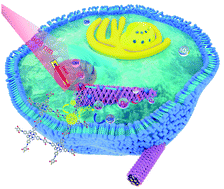π–π conjugation promoted nanocatalysis for cancer therapy based on a covalent organic framework†
Abstract
The production of reactive oxygen species (ROS) to elicit lethal cellular oxidative damage is an attractive pathway to kill cancer cells, but it is still hindered by the low ROS production efficiency of the current methods. Herein, we design a one-dimensional (1D) π–π conjugated ferriporphyrin covalent organic framework on carbon nanotubes (COF-CNT) for activating nanocatalytic and photodynamic cancer therapy. The COF-CNT can catalyze the generation of ROS and O2 in the tumor microenvironment (TME), and realize a self-oxygen-supplying PDT under near-infrared (NIR) light irradiation, simultaneously. With the full electron delocalization at the atomically dispersed active center, the catalytic activity of COF-CNT with extended π-conjugation is 6.8 times higher than that without the π-conjugated structure. The formation of the COF structure with π–π conjugation also changes the density of states (DOS) profile of its functional building block for improving PDT. Through one single treatment, it successfully achieves complete tumor regression of 4T1 breast carcinoma in mice with immunoregulation.



 Please wait while we load your content...
Please wait while we load your content...